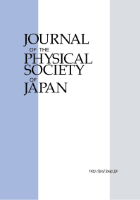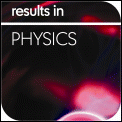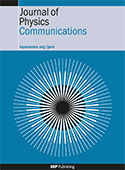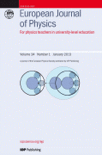
REVISTA MEXICANA DE FISICA
Scope & Guideline
Empowering Scientific Discourse in Physics and Astronomy
Introduction
Aims and Scopes
- Theoretical Physics:
Focuses on the development of new theories and models to explain physical phenomena, including quantum mechanics, relativity, and statistical mechanics. - Material Science:
Explores the properties and applications of various materials, including semiconductors, nanomaterials, and biomaterials, often through experimental and computational studies. - Nanotechnology:
Investigates nanoscale materials and their unique properties, applications in electronics, photonics, and medicine, often involving synthesis and characterization. - Condensed Matter Physics:
Studies the behavior of condensed phases of matter, including phenomena such as superconductivity, magnetism, and phase transitions. - Applied Physics:
Covers practical applications of physics principles in technology and engineering, including advancements in sensors, optics, and energy materials. - Interdisciplinary Research:
Encourages collaboration across different scientific fields, integrating physics with chemistry, biology, and engineering to address complex problems.
Trending and Emerging
- Quantum Computing and Information:
An increasing number of studies explore quantum algorithms, quantum entanglement, and their applications, reflecting the rapid growth of the quantum computing field. - Nanomaterials and Nanoengineering:
Research on the synthesis, characterization, and application of nanomaterials is burgeoning, driven by their potential in electronics, medicine, and environmental science. - Biophysics and Biomaterials:
The intersection of physics with biology is gaining prominence, with studies focusing on the physical properties of biological systems and the development of biomaterials. - Machine Learning in Physics:
The integration of machine learning techniques in data analysis and predictive modeling is becoming increasingly popular, showcasing the journal's adaptation to modern computational methods. - Energy Materials and Sustainability:
Research focused on materials for energy conversion and storage, including solar cells and batteries, is on the rise, reflecting global efforts towards sustainable energy solutions.
Declining or Waning
- Classical Mechanics:
Research in classical mechanics has seen a decline, likely overshadowed by advancements in more contemporary fields such as quantum mechanics and condensed matter physics. - Basic Nuclear Physics:
While still relevant, papers focusing solely on fundamental nuclear physics concepts are increasingly rare, as the field shifts towards applications in nuclear technology and medical physics. - Astrophysics:
Research related to classical astrophysical phenomena has waned, with fewer studies being published compared to the rising interest in experimental and observational astrophysics. - Thermodynamics of Simple Systems:
There is a noticeable decrease in publications addressing basic thermodynamic principles, possibly due to a growing focus on complex systems and statistical mechanics. - Geophysical Physics:
The interest in geophysical physics has declined, as researchers increasingly turn towards applied and computational techniques for understanding Earth's processes.
Similar Journals

JOURNAL OF THE PHYSICAL SOCIETY OF JAPAN
Catalyzing Knowledge Exchange in Physics and AstronomyThe JOURNAL OF THE PHYSICAL SOCIETY OF JAPAN, published by the Physical Society of Japan, has been at the forefront of advancing knowledge in the field of Physics and Astronomy since its inception in 1946. With a commendable reputation reflected in its Q2 ranking within its category for 2023, this journal serves as a vital platform for disseminating high-quality research and innovative concepts. Researchers and professionals alike can engage with cutting-edge studies and reviews that span a diverse range of topics pivotal to the physical sciences. Although the journal does not currently operate with an open access model, it maintains a robust impact on the global physics community, evidenced by its placement in the 59th percentile among a competitive pool of 243 journals. With an unwavering commitment to bridging theory and application, the JOURNAL OF THE PHYSICAL SOCIETY OF JAPAN continues to inspire and cultivate scholarly discourse and collaboration across disciplines.

Results in Physics
Innovative Insights for Tomorrow's PhysicsResults in Physics, an esteemed open-access journal published by ELSEVIER, has been a prominent platform for disseminating cutting-edge research in the field of physics since its establishment in 2011. With its ISSN 2211-3797 and E-ISSN 2211-3797, this journal proudly holds a Q2 ranking in the Physics and Astronomy category for 2023, showcasing its significance and quality within the scientific community. With a remarkable Scopus rank of #28 out of 243 in the general physics and astronomy domain, placing it within the 88th percentile, Results in Physics serves as a vital resource for researchers, professionals, and students alike, fostering a collaborative environment for the advancement of knowledge across various subfields. The journal aims to provide a rapid and unrestricted access to innovative findings, encouraging open scientific dialogue and enhancing the visibility of breakthrough research. Located in the Netherlands at RADARWEG 29, 1043 NX AMSTERDAM, Results in Physics continues to uphold its commitment to excellence and accessibility in the ever-evolving landscape of physics research.

DOKLADY PHYSICS
Connecting Theory and Application in Mechanics.DOKLADY PHYSICS is a prominent academic journal dedicated to advancing knowledge in the fields of computational mechanics, mechanics of materials, and general physics and astronomy. Published by MAIK NAUKA/INTERPERIODICA/SPRINGER, this journal has established itself as a crucial resource for researchers and professionals keen on exploring the intricacies of physical phenomena and engineering applications. With its ISSN 1028-3358 and E-ISSN 1562-6903, DOKLADY PHYSICS has been contributing to scientific discourse since its inception in 1996 and continues to provide a platform for innovative research up to 2023. Despite its current Q3 ranking in several key categories, the journal maintains an inclusive approach, striving to influence both academic and practical aspects of its fields. While the journal may not be open access, it remains a vital publication for those interested in high-quality research, as reflected in its Scopus ranking positions across various engineering and physics categories.

ACTA PHYSICA POLONICA A
Advancing the Frontiers of Physics and AstronomyACTA PHYSICA POLONICA A is a distinguished peer-reviewed journal published by the Polish Academy of Sciences Institute of Physics, offering a platform for disseminating cutting-edge research in the field of physics and astronomy. With an ISSN of 0587-4246 and an E-ISSN of 1898-794X, this journal has been a staple for scholars since its inception, converging its publication years from 1996 to 2024. Despite its current Q4 classification in the Physics and Astronomy (miscellaneous) category, ACTA PHYSICA POLONICA A provides valuable insights and breakthroughs addressing various aspects of general physics. Researchers, professionals, and students will find a wealth of knowledge within its pages, even as it operates in an evolving academic landscape. While subscription options exist, the journal aims to foster collaboration and knowledge exchange in the physics community, making it a vital resource for those seeking to stay at the forefront of research advancements.

Condensed Matter Physics
Inspiring Future Discoveries in Condensed MatterCondensed Matter Physics is a prestigious open-access journal published by the Institute of Condensed Matter Physics, National Academy of Sciences Ukraine. Since its inception in 1993, this journal has been dedicated to the dissemination of high-quality research in the field of condensed matter physics, providing a platform for scientists worldwide to share their latest findings. With an ISSN of 1607-324X and an E-ISSN of 2224-9079, it caters to a diverse audience, including researchers, professionals, and students. Although classified in the Q4 quartile for both condensed matter physics and miscellaneous physics and astronomy category, the journal plays a vital role in fostering communication among experts and advancing knowledge in this dynamic field. It is particularly vital for emerging researchers as it supports open access, ensuring that critical research is available to all, removing barriers to information. The journal's relevance remains steadfast, covering a wide array of topics and encouraging interdisciplinary approaches, and it is poised to inspire future scientific explorations until at least 2024.

Frontiers of Physics
Fostering Collaboration for a Brighter Physics FutureFrontiers of Physics, published by Higher Education Press, is a premier open-access journal dedicated to fostering innovative research and excellence within the field of physics. With an ISSN of 2095-0462 and an E-ISSN of 2095-0470, this rapidly growing journal has established itself as a valuable platform for disseminating cutting-edge findings, covering a diverse range of topics from theoretical frameworks to experimental advancements. Notably, Frontiers of Physics has achieved an impressive Q1 ranking in the 2023 Scopus Quartiles for Physics and Astronomy, securing a competitive 5th out of 81 positions in its category, reflecting a high impact factor that underscores its importance to the scientific community. Since its inception in 2011 and continuing through 2024, the journal aims to bridge the gap between academia and industry, encouraging collaboration among researchers, professionals, and students alike. Its commitment to open access ensures that high-quality research is readily accessible, thereby promoting knowledge sharing and advancement in the global physics community. Explore the potential of your research in Frontiers of Physics, where the future of physics flourishes.

JETP LETTERS
Elevating Scientific Discourse in Physics and AstronomyJETP LETTERS, published by MAIK NAUKA/INTERPERIODICA/SPRINGER, is a prestigious journal in the field of physics and astronomy, which plays a pivotal role in disseminating groundbreaking research and innovative ideas since its inception in 1969. With an ISSN of 0021-3640 and an E-ISSN of 1090-6487, this journal aligns well with the interests of both seasoned researchers and emerging scholars, having achieved a 2023 category rank of Q3 for miscellaneous topics within physics and astronomy. Located in the United States at 233 SPRING ST, NEW YORK, NY 10013-1578, JETP LETTERS serves as a critical resource for its readership, offering exclusive insights and advancements across diverse areas of physics. While not open access, it hosts a collection of articles that refine theoretical approaches and experimental methods, providing both knowledge and inspiration to professionals and academics seeking to make impactful contributions to the scientific community. The journal’s quality is reflected in its Scopus ranking, where it stands at 39 out of 81 in the multidisciplinary category, placing it in the 52nd percentile, thus underscoring its significance and reliability as a scholarly outlet.

Journal of Physics Communications
Advancing Physics Through Open DialogueJournal of Physics Communications, published by IOP Publishing Ltd, serves as a significant platform for the dissemination of innovative research in the realm of physics and astronomy. Since its inception in 2017, this Open Access journal has fostered a collaborative environment, allowing researchers, professionals, and students to share their findings and ideas without barriers. With an ISSN of 2399-6528, the journal has established its credibility in the academic community, achieving a ranking of Q3 in the 2023 category of Physics and Astronomy (miscellaneous), as well as a respectable position in Scopus with a rank of #122 out of 243 in its field. The journal's focus is on bridging theoretical concepts and practical applications, making it an essential resource for those engaged in the evolving landscape of physics. The Journal of Physics Communications not only aims to advance knowledge but also to inspire interdisciplinary collaboration, inviting contributions from diverse areas within physics. Authors and readers alike will find this journal particularly beneficial to stay updated on emerging trends and innovative research.

EUROPEAN JOURNAL OF PHYSICS
Driving Excellence in Physics ResearchEuropean Journal of Physics, published by IOP Publishing Ltd, is a premier international journal serving the diverse field of physics and astronomy. With a commitment to advancing scientific knowledge since its inception in 1980, the journal provides a platform for original research articles, reviews, and topical discussions in various domains, including theoretical and experimental physics. Operating out of the United Kingdom, the journal has achieved a commendable Q2 ranking in the Physics and Astronomy (miscellaneous) category for 2023, reflecting its robust influence in the academic community, alongside a notable Scopus Rank that underscores its relevance in both the Social Sciences and General Physics and Astronomy fields. Although it does not currently offer open access, the journal's traditional publication model ensures rigorous peer review, maintaining high scholarly standards that are imperative for researchers, professionals, and students striving to stay ahead in their respective fields. Don't miss the opportunity to engage with cutting-edge research and contribute to the ongoing dialogue in physics by accessing this vital resource.

INDIAN JOURNAL OF PHYSICS
Advancing the Frontiers of Physics and AstronomyINDIAN JOURNAL OF PHYSICS, published by the Indian Association for Cultivation of Science, serves as a pivotal platform for researchers and scholars in the field of physics and astronomy. With its ISSN 0973-1458 and E-ISSN 0974-9845, this journal is committed to presenting innovative research and developments across diverse topics in physics, covering both theoretical and experimental studies. The journal has made its mark in the academic community, evidenced by its classification in the Q3 category within the Physics and Astronomy domain as of 2023, and ranks #100 out of 243 in the Scopus curated database, placing it in the 59th percentile. Spanning from 2005 to 2024, the INDIAN JOURNAL OF PHYSICS aims to foster knowledge exchange and stimulate discussions among physicists and scientific enthusiasts. Whether you are a researcher looking to publish your findings, a professional seeking updates in your field, or a student eager to explore varying aspects of physics, this journal is an invaluable resource contributing significantly to the understanding and advancement of physics in India and beyond.